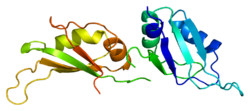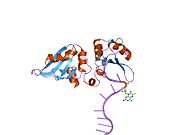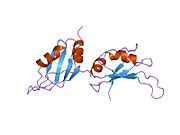HNRNPA1
Heterogeneous nuclear ribonucleoprotein A1 is a protein that in humans is encoded by the HNRNPA1 gene.[4] Mutations in hnRNP A1 are causative of amyotrophic lateral sclerosis and the syndrome multisystem proteinopathy.
Function
[edit]This gene belongs to the A/B subfamily of ubiquitously expressed heterogeneous nuclear ribonucleoproteins (hnRNPs). The hnRNPs are RNA binding proteins and they complex with heterogeneous nuclear RNA (hnRNA). These proteins are associated with pre-mRNAs in the nucleus and appear to influence pre-mRNA processing and other aspects of mRNA metabolism and transport. While all of the hnRNPs are present in the nucleus, some seem to shuttle between the nucleus and the cytoplasm. The hnRNP proteins have distinct nucleic acid binding properties. The protein encoded by this gene has two repeats of quasi-RRM domains that bind to RNAs in the N-terminal domain which are pivotal for RNA specificity and binding. The protein also has a glycine rich arginine-glycine-glycine (RGG) region called the RGG box which enables protein and RNA binding. It affects many critical genes that are responsible for controlling metabolic pathways at the transcriptional, post-transcriptional, translation, and post-translation levels. It is one of the most abundant core proteins of hnRNP complexes and it is localized to the nucleoplasm. This protein, along with other hnRNP proteins, is exported from the nucleus, probably bound to mRNA, and is immediately re-imported. Its M9 nuclear localisation sequence (NLS), a glycine rich region downstream from the RGG box, acts as both a nuclear localization and nuclear export signal. The encoded protein is involved in the packaging of pre-mRNA into hnRNP particles, transport of poly A+ mRNA from the nucleus to the cytoplasm, and may modulate splice site selection. Multiple alternatively spliced transcript variants have been found for this gene but only two transcripts are fully described. These variants have multiple alternative transcription initiation sites and multiple polyA sites.[5]
Post translational modifications are also known to affect hnRNP A1's function. Methylation of arginine residues in the RGG box may regulate RNA-binding activity. Kinases such as protein kinase C (PKC), mitogen-activated protein kinases (MAPKs), and ribosomal S6 kinases (S6Ks) phosphorylate serine residues at both the N and C terminals to regulate function. Phosphorylation of the C-terminal region causes cytoplasmic accumulation of the protein. However, addition of O-GlcNAcylation (GlcNAc) moiety to serine or threonince is a common and reversible modification that impairs the protein's binding of karyopherin beta (Transportin-1) resulting in nuclear localization of hnRNPA1.[6]
Interactions
[edit]hnRNP A1 has been shown to interact with BAT2,[7] Flap structure-specific endonuclease 1[8] and IκBα.[9]
Role in Viruses
[edit]hnRNP A1 is involved in the life cycle of DNA, positive sense RNA, and negative sense RNA viruses are multiple stages post-infection. The proteins role in viral life cycles varies depending on the virus and can even play contradictory roles. In some, it promotes viral replication while in others, it abrogates it.
hnRNP A1's anti-viral effect is present in human T-cell lymphotropic virus type I (HTLV-1) cell culture model. hnRNP A1 inhibits the binding of Rex protein to its response element in 3’ long terminal repeat (LTR) of all viral RNAs. Ectopic expression of hnRNP A1 antagonizes post-transcriptional activity of Rex via competitive binding, eliciting an antiviral response against HTLV-1 infection by negatively affecting the rate of viral replication. In the case of Hepatitis C virus (HCV), a positive sense RNA virus, hnRNP A1 interacts with a crucial region near the 3’ end of the virus’ open reading frame (ORF) called the cis-acting replication element. When hnRNP A1 is upregulated, HCV replication decreases and when hnRNPA1 is downregulated, HCV replication increases.
hnRNP A1's pro-viral effect is present in the Sindbis virus (a positive sense RNA virus) infection model. hnRNP A1 has been found redistributed in the cytoplasmic site of viral replication bound to the 5’ UTR region of the viral RNA, promoting synthesis of negative-strand RNA. hnRNP A1 has a similar role in porcine epidemic diarrhea virus (PEDV) infection in which hnRNP A1 co-immunoprecipitates with PEDV nucleocapsid protein during infection. hnRNP A1 also bound to terminal leader sequences and intergenic sequences that are crucial for efficient viral replication. Similar trends have also been observed in rhinovirus (HRV), enterovirus 71 (EV-71), and avian reovirus (ARV) infections.
In the case of some viruses, such as human immunodeficiency virus 1 (HIV-1), contradictory results have been reported in different research studies. Monette et al. reported increased endogenous expression of hnRNP A1 after HIV-1 infection, as enhanced hnRNPA1 levels were seen as favorable for the virus. They also found that down regulation of hnRNPA1 negatively affected viral replication. In contrast, Zahler et al. found that over expression of hnRNP A1 in vitro adversely affected viral replication. As a result, the role of hnRNPA1 in HIV-1's life cycle is somewhat controversial.[6]
Role in other disease
[edit]Mutations in hnRNP A1 are a cause of amyotrophic lateral sclerosis and multisystem proteinopathy.
hnRNP A1 antagonizes cellular senescence and induction of the senescence-associated secretory phenotype by stabilizing Oct-4 and sirtuin 1 mRNAs.[10][11]
References
[edit]- ^ a b c GRCm38: Ensembl release 89: ENSMUSG00000046434 – Ensembl, May 2017
- ^ "Human PubMed Reference:". National Center for Biotechnology Information, U.S. National Library of Medicine.
- ^ "Mouse PubMed Reference:". National Center for Biotechnology Information, U.S. National Library of Medicine.
- ^ Saccone S, Biamonti G, Maugeri S, Bassi MT, Bunone G, Riva S, Della Valle G (Mar 1992). "Assignment of the human heterogeneous nuclear ribonucleoprotein A1 gene (HNRPA1) to chromosome 12q13.1 by cDNA competitive in situ hybridization". Genomics. 12 (1): 171–4. doi:10.1016/0888-7543(92)90424-Q. PMID 1733858.
- ^ "Entrez Gene: HNRPA1 heterogeneous nuclear ribonucleoprotein A1".
- ^ a b Kaur R, Lal SK (March 2020). "The multifarious roles of heterogeneous ribonucleoprotein A1 in viral infections". Reviews in Medical Virology. 30 (2): e2097. doi:10.1002/rmv.2097. PMC 7169068. PMID 31989716.
- ^ Lehner B, Semple JI, Brown SE, Counsell D, Campbell RD, Sanderson CM (Jan 2004). "Analysis of a high-throughput yeast two-hybrid system and its use to predict the function of intracellular proteins encoded within the human MHC class III region". Genomics. 83 (1): 153–67. doi:10.1016/S0888-7543(03)00235-0. PMID 14667819.
- ^ Chai Q, Zheng L, Zhou M, Turchi JJ, Shen B (Dec 2003). "Interaction and stimulation of human FEN-1 nuclease activities by heterogeneous nuclear ribonucleoprotein A1 in alpha-segment processing during Okazaki fragment maturation". Biochemistry. 42 (51): 15045–52. doi:10.1021/bi035364t. PMID 14690413.
- ^ Hay DC, Kemp GD, Dargemont C, Hay RT (May 2001). "Interaction between hnRNPA1 and IkappaBalpha is required for maximal activation of NF-kappaB-dependent transcription". Mol. Cell. Biol. 21 (10): 3482–90. doi:10.1128/MCB.21.10.3482-3490.2001. PMC 100270. PMID 11313474.
- ^ Han Y, Ramprasath T, Zou M (2020). "β-hydroxybutyrate and its metabolic effects on age-associated pathology". Experimental & Molecular Medicine. 52 (4): 548–555. doi:10.1038/s12276-020-0415-z. PMC 7210293. PMID 32269287.
- ^ Stubbs BJ, Koutnik AP, Volek JS, Newman JC (2021). "From bedside to battlefield: intersection of ketone body mechanisms in geroscience with military resilience". GeroScience. 43 (3): 1071–1081. doi:10.1007/s11357-020-00277-y. PMC 8190215. PMID 33006708.
Further reading
[edit]- Kim S, Park GH, Paik WK (1999). "Recent advances in protein methylation: enzymatic methylation of nucleic acid binding proteins". Amino Acids. 15 (4): 291–306. doi:10.1007/BF01320895. PMID 9891755. S2CID 28412209.
- Buvoli M, Cobianchi F, Bestagno MG, Mangiarotti A, Bassi MT, Biamonti G, Riva S (1990). "Alternative splicing in the human gene for the core protein A1 generates another hnRNP protein". EMBO J. 9 (4): 1229–35. doi:10.1002/j.1460-2075.1990.tb08230.x. PMC 551799. PMID 1691095.
- Ghetti A, Bolognesi M, Cobianchi F, Morandi C (1991). "Modeling by homology of RNA binding domain in A1 hnRNP protein". FEBS Lett. 277 (1–2): 272–6. doi:10.1016/0014-5793(90)80863-E. PMID 2176620. S2CID 29915150.
- Biamonti G, Buvoli M, Bassi MT, Morandi C, Cobianchi F, Riva S (1989). "Isolation of an active gene encoding human hnRNP protein A1. Evidence for alternative splicing". J. Mol. Biol. 207 (3): 491–503. doi:10.1016/0022-2836(89)90459-2. PMID 2760922.
- Buvoli M, Biamonti G, Tsoulfas P, Bassi MT, Ghetti A, Riva S, Morandi C (1988). "cDNA cloning of human hnRNP protein A1 reveals the existence of multiple mRNA isoforms". Nucleic Acids Res. 16 (9): 3751–70. doi:10.1093/nar/16.9.3751. PMC 336554. PMID 2836799.
- Riva S, Morandi C, Tsoulfas P, Pandolfo M, Biamonti G, Merrill B, Williams KR, Multhaup G, Beyreuther K, Werr H (1986). "Mammalian single-stranded DNA binding protein UP I is derived from the hnRNP core protein A1". EMBO J. 5 (9): 2267–73. doi:10.1002/j.1460-2075.1986.tb04494.x. PMC 1167110. PMID 3023065.
- Epplen C, Epplen JT (1994). "Expression of (cac)n/(gtg)n simple repetitive sequences in mRNA of human lymphocytes". Hum. Genet. 93 (1): 35–41. doi:10.1007/BF00218910. PMID 7505766. S2CID 22998633.
- Siomi H, Dreyfuss G (1995). "A nuclear localization domain in the hnRNP A1 protein". J. Cell Biol. 129 (3): 551–60. doi:10.1083/jcb.129.3.551. PMC 2120450. PMID 7730395.
- Weighardt F, Biamonti G, Riva S (1995). "Nucleo-cytoplasmic distribution of human hnRNP proteins: a search for the targeting domains in hnRNP A1". J. Cell Sci. 108 (2): 545–55. doi:10.1242/jcs.108.2.545. PMID 7769000.
- Rajpurohit R, Lee SO, Park JO, Paik WK, Kim S (1994). "Enzymatic methylation of recombinant heterogeneous nuclear RNP protein A1. Dual substrate specificity for S-adenosylmethionine:histone-arginine N-methyltransferase". J. Biol. Chem. 269 (2): 1075–82. doi:10.1016/S0021-9258(17)42223-X. PMID 8288564.
- Hamilton BJ, Nagy E, Malter JS, Arrick BA, Rigby WF (1993). "Association of heterogeneous nuclear ribonucleoprotein A1 and C proteins with reiterated AUUUA sequences". J. Biol. Chem. 268 (12): 8881–7. doi:10.1016/S0021-9258(18)52955-0. PMID 8473331.
- Michael WM, Choi M, Dreyfuss G (1996). "A nuclear export signal in hnRNP A1: a signal-mediated, temperature-dependent nuclear protein export pathway". Cell. 83 (3): 415–22. doi:10.1016/0092-8674(95)90119-1. PMID 8521471. S2CID 615927.
- Black AC, Luo J, Chun S, Bakker A, Fraser JK, Rosenblatt JD (1997). "Specific binding of polypyrimidine tract binding protein and hnRNP A1 to HIV-1 CRS elements". Virus Genes. 12 (3): 275–85. doi:10.1007/bf00284648. PMID 8883365. S2CID 11678179.
- Bonaldo MF, Lennon G, Soares MB (1997). "Normalization and subtraction: two approaches to facilitate gene discovery". Genome Res. 6 (9): 791–806. doi:10.1101/gr.6.9.791. PMID 8889548.
- Xu RM, Jokhan L, Cheng X, Mayeda A, Krainer AR (1997). "Crystal structure of human UP1, the domain of hnRNP A1 that contains two RNA-recognition motifs". Structure. 5 (4): 559–70. doi:10.1016/S0969-2126(97)00211-6. PMID 9115444.
- Bonifaci N, Moroianu J, Radu A, Blobel G (1997). "Karyopherin beta2 mediates nuclear import of an mRNA binding protein". Proc. Natl. Acad. Sci. U.S.A. 94 (10): 5055–60. Bibcode:1997PNAS...94.5055B. doi:10.1073/pnas.94.10.5055. PMC 24630. PMID 9144189.
- Shamoo Y, Krueger U, Rice LM, Williams KR, Steitz TA (1997). "Crystal structure of the two RNA binding domains of human hnRNP A1 at 1.75 A resolution". Nat. Struct. Biol. 4 (3): 215–22. doi:10.1038/nsb0397-215. PMID 9164463. S2CID 9381013.
- Neubauer G, King A, Rappsilber J, Calvio C, Watson M, Ajuh P, Sleeman J, Lamond A, Mann M (1998). "Mass spectrometry and EST-database searching allows characterization of the multi-protein spliceosome complex". Nat. Genet. 20 (1): 46–50. doi:10.1038/1700. PMID 9731529. S2CID 585778.


















